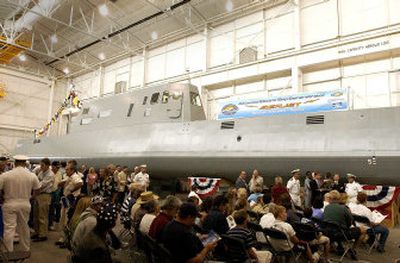Navy’s christens destroyer prototype

BAYVIEW, Idaho – Within weeks, the U.S. Navy’s newest ship will be cruising the waters of Lake Pend Oreille, testing the same jet propulsion and stealth technology that the Navy hopes to employ in its next generation of destroyers.
Although the Sea Jet is 133 feet long and capable of traveling at near-highway speeds, the vessel is expected to run as silently as a nuclear submarine. The ship, which will be permanently based at the lake, might turn heads when it zooms past pleasure boaters and kayakers, but its radical hull design is supposed to show up on enemy radar screens as nothing more than a fishing boat.
“The performance of this vessel will lead the Navy to future technological advances that will ultimately benefit the men and women at the point of the spear,” said Capt. Charles D. Berle, commander of the Naval Surface Warfare Center’s Carderock Division, which oversees the Acoustic Research Detachment in Bayview. Berle spoke Wednesday at the ship’s christening ceremony.
The Sea Jet is one-quarter the scale of the Navy’s upcoming DDX class of destroyers – the Navy hopes to launch eight of the full-size destroyers within five years. The smaller size of the Sea Jet makes it easier and cheaper to test new technologies, said Rear Adm. Jay M. Cohen, chief of the Navy’s Office of Naval Research. The Sea Jet cost $16 million and was built by Dakota Creek Industries, of Anacortes, Wash.
Sea battles have long favored fleets with the best technology and the Sea Jet will help the United States achieve “stunning victories,” Cohen said, speaking to a crowd of at least 500 local residents, government officials, defense contractors and sailors. Two hundred years ago, British Adm. Horatio Nelson used superior gunnery and new tactics to whip the combined Spanish and French fleets, despite Nelson’s smaller force.
“Think of what Nelson could do with Sea Jet,” Cohen said.
Idaho might be more than 300 miles from the nearest ocean, but the state has played an important role in creating the most powerful navy in history, Cohen said. During World War II, nearly 300,000 servicemen passed through the Farragut Naval Training Station on Lake Pend Oreille.
In the 1950s, nuclear reactors for submarines were developed at the Idaho National Laboratory near Arco. The Acoustic Research Detachment in Bayview is also home to the world’s longest unmanned submarine, the 111-foot Cutthroat, which is helping the Navy develop the world’s best underwater stealth technology.
Oceans are filled with background noise – currents, large waves, sea life and other large vessels – but the 1,500-foot-deep Lake Pend Oreille offers a “near-perfect” acoustical environment for testing new technology, said Stephen Schreppler, the Sea Jet’s project manager. The ship was built to allow engineers to make quick swaps of major components.
The aluminum deckhouse, for example, will eventually be unbolted and replaced with a super-light, ultra-strong structure woven from carbon fibers, Schreppler said. The material is virtually invisible on radar. The sides of the wave-piercing hull also slope inwards above the waterline, adding an additional layer of stealth by reducing rocking from waves.
Schreppler offered a brief tour of the deckhouse, which reeked of fresh paint and was bathed in red fluorescent light. Four wardrobe-size cabinets behind the cockpit hold computers that will gather data on all manner of the ship’s operation. Secure wireless Internet connections will beam the information to scientists in Bayview and at other Navy research facilities.
The deckhouse contains fewer gauges than most cars, just four touch-screen displays, which allow the captain to control every aspect of the ship. There was, however, a large compass.
“You’ve always got to have a mechanical compass. That’s a Navy tradition,” Schreppler explained. “It will never fail when the power goes off.”
One of the most radical changes being tested on the Sea Jet is a water jet propulsion system that totally eliminates the need for propeller, shaft and rudder. The pair of 400-horsepower, electric-driven Rolls-Royce water jets swivel and steer the ship by directional thrust. The technology allows the Sea Jet to “turn on a dime” and pivot on its centerline, Adm. Cohen said, standing below the hull to show off the thrusters moments before the christening ceremony.
The water jets are quiet, light and have few moving parts to maintain, Cohen said. The units are designed to run 25 feet below surface and leave behind very little wake, water swirl or bubbles. A Rolls-Royce engineer, who operated the unit by remote control during the demonstration, had a simple description: “Jet skis on steroids,” he said, grinning.
World War II veteran Jim Sheppard served in a VFW honor guard at the christening. The Coeur d’Alene resident spent his time in the Navy aboard amphibious troop carriers in the Pacific, European and North African theaters of the war.
“I was a carpenter’s mate. They don’t even have those anymore,” Sheppard said, pausing to gaze at the science fiction-like Sea Jet. “This sure is something!”